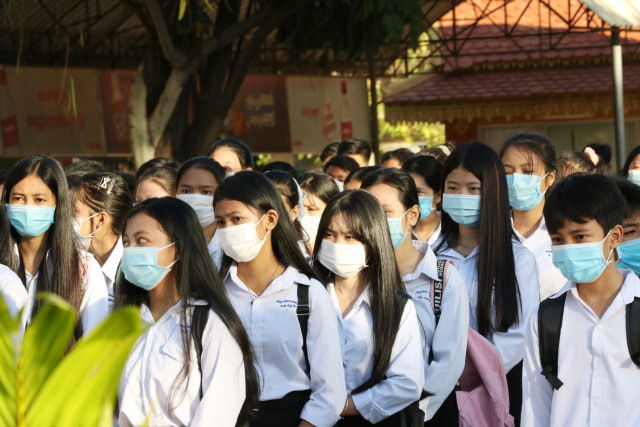Economic Expert Is Optimistic about Cambodia Moving on from Least-Developed Country Status

- By Thun Senghong
- March 24, 2024 4:30 PM
Phnom Penh — The Cambodian government has set the goal of having the country leave the ranks of the Least Developed Countries (LDCs) by 2027. This is also the year the United Nations Development Policy Committee had projected in 2021 that this would happen. According to Ky Sereyvath, an economy expert with the Royal Academy of Cambodia, accomplishing this would help the country gain independence in the economic sector, and especially support the development of the agriculture sector and human resources, which would contribute to Cambodia's economic growth.
Sereyvath was speaking during a roundtable discussion on the “Assessment of Implications for Cambodia's Least Developed Country Graduation,” which was held by the Cambodian Development Center on March 21.
After Cambodia has moved on from its status of Least Developed Country to being considered a developed country, the agricultural sector will benefit from the change of status, he said. “[W]e will get the GPS+ [satellite positioning system] from the European Union, and we will export agricultural products, which are at least 50 percent local raw materials,” Sereyvath said.
While losing poor-country status always has consequences for a country, self-reliance is a better option than relying on help from others, he said.
In recent years, Cambodia has been considered a fast-growing economy due to an economic growth of around 7 percent, except during the COVID-19 pandemic that affected virtually all countries.
The ranking of Least Developed Countries is set by the United Nations and determined by using three criteria: Gross National Income (GNI) per capita, Human Assets Index (HAI), and Economic and Environmental Vulnerability Index (EVI).
 A roundtable discussion on the "Assessment of Implications: Cambodia's Least Developed Country Graduation" was held by the Cambodian Development Center on March 21 at the Mani Center in The Kampus. Photo: Cambodian Development Center
A roundtable discussion on the "Assessment of Implications: Cambodia's Least Developed Country Graduation" was held by the Cambodian Development Center on March 21 at the Mani Center in The Kampus. Photo: Cambodian Development Center
As part of its seventh mandate, the government is focusing on human resource development to train 1.5 million skilled workers over the next five years. This is seen as a crucial strategy to lift Cambodia out of poverty, according to economists.
In the past, Cambodia, as a least-developed country, benefitted from the EBA tariffs—Everything But Arms (EBA) duty-free and quota-free access—in the European Union, and the GSP—Generalized System of Preferences—of the United States to boost its exports. (Twenty percent of the EBA tariff preferences granted to Cambodia were suspended by the European Commission in February 2020 based on alleged “violations of the human rights principles.”)
Relying on these tax incentives has limited Cambodia's production, Sereyvath said. Based on his analysis, Cambodia's economic productivity has not been that dynamic as only $3 per hour was obtained for every $1 invested, which is still lower than some ASEAN countries.
Regarding whether exports may have an impact on Cambodia's decision to withdraw from the least-developed country category, according to Sereyvath, exports to the European Union have been since 2019 except in 2023, when a phase of the global economic crisis led to a 12-to-13 percent decline of Cambodia’s exports.
Taxes do not prevent traders from exporting their goods, Sereyvat said. “Therefore, the withdrawal of EBA does not mean the closure of Cambodian factories. Withdrawal of EBA [in 2020] has led traders to innovate more in production and export.”
Generally speaking, Cambodia's international reputation is set to improve significantly as a result of leaving the Least Developed Countries category, he said.
This move is expected to create a favorable investment climate and strengthen the country's infrastructure, Sereyvat said. Moreover, it is anticipated that Cambodia will see an increase in foreign direct investment, which will further enhance its economic growth prospects, he said.
Still, this change of status may also have negative consequences, Sereyvat said, such as loss of international trade support as in reduced subsidies and co-financing from partners, and limited access to development assistance from these partners.
In the meantime, he said, it is imperative for Cambodia to strengthen major sectors such as industry and tourism to enable a smooth and robust emergence from the least-developed country status. Already, there is an emphasis on value-added growth driven by the utilization of human capital and technology by companies, he said.
As Sereyvat pointed out, Cambodia has numerous natural sites for eco-tourism that need to be promoted while the global tourism sector is stagnant, providing Cambodia with the time needed to review and develop additional tourism approaches.
There could be marketing approaches such as, he said, “visit Cambodia, eat organic food, and breathe fresh air,” while the world economy recovers. “The service sector will contribute to economic growth,” Sereyvat added.
The United Nations’ list of least-developed countries currently includes 45 countries. Bangladesh, Laos and Nepal are set to leave the ranking in 2026, while Bhutan was taken off the list in December 2023.
Originally written in Khmer for ThmeyThmey, this story was translated by Chhuon Kongieng for Cambodianess.















